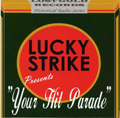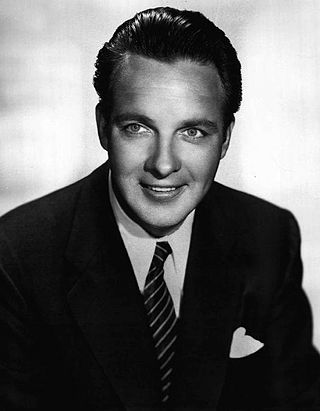Related Research Articles
The year 1957 in television involved some significant events. Below is a list of television-related events during 1957.

Your Hit Parade was an American radio and television music program that was broadcast from 1935 to 1953 on radio, and seen from 1950 to 1959 on television. It was sponsored by American Tobacco's Lucky Strike cigarettes. During its 24-year run, the show had 19 orchestra leaders and 52 singers or groups. Many fans inaccurately referred to the show as The Hit Parade.

Gisèle MacKenzie was a Canadian-American singer, actress, and commercial spokesperson, best known for her performances on the US television program Your Hit Parade.

Dinah Shore was an American singer, actress, and television personality, and the top-charting female vocalist of the 1940s. She rose to prominence as a recording artist during the Big Band era. She achieved even greater success a decade later in television, mainly as the host of a series of variety programs for the Chevrolet automobile company.

George Robert Crosby was an American jazz singer and bandleader, best known for his group the Bob-Cats, which formed around 1935. The Bob-Cats were a New Orleans Dixieland-style jazz octet. He was the younger brother of famed singer and actor Bing Crosby. On TV, Bob Crosby guest-starred in The Gisele MacKenzie Show. He was also a regular cast member of The Jack Benny Program, on both radio and television, taking over the role of bandleader after Phil Harris' departure. Crosby hosted his own afternoon TV variety show on CBS, The Bob Crosby Show (1953–1957). Crosby received two stars on the Hollywood Walk of Fame, for television and radio.
Don Messer's Jubilee was a Canadian folk musical variety show first broadcast on radio and later on television. The radio version aired from produced from 1939 to 1958 in Charlottetown for CBC Radio. The Television version show shot at the studios of CBHT in Halifax, Nova Scotia, Canada. It was broadcast by CBC Television nationwide from 1957 until 1969, after almost two decades in various formats on CBC radio.
Sylvia Murphy was a Canadian singer who was popular on radio and television programs on the CBC from 1949 to 1964.

The Garry Moore Show is the name for several separate American variety series on the CBS television network in the 1950s and 1960s. Hosted by experienced radio performer Garry Moore, the series helped launch the careers of many comedic talents, such as Dorothy Loudon, Don Adams, George Gobel, Carol Burnett, Don Knotts, Lee Goodman, James Kirkwood, Jr., Lily Tomlin, and Jonathan Winters. The Garry Moore Show garnered a number of Emmy nominations and wins.
Let's Go started at CBC Vancouver as a summer musical series for teenagers, July 17, 1964, to Sept. 4, 1964. There were 8 Lets Go shows produced and broadcast locally on CBUT Vancouver, Friday evenings at 7:30 PM. Fred Latremouille and Randi Conlin were Hosts, with the Classics as the house band. Regular performers were Gillian Russell, Susan Pesklevits, Mike Campbell, Nancy Davis, Tom Northcott, Howie Vickers, Marcel Chouinard, Stan Cayer, and Ed Whiting. Produced and directed by Ain Soodor, script assistant Chris Paton, studio director Al Vitols.

Roy Landman, better known as Snooky Lanson, was an American singer known for co-starring on the NBC television series Your Hit Parade.
In Person is a Canadian music variety television series which aired on CBC Television from 1966 to 1968.
On Stage is a Canadian music variety television series which aired on CBC Television from 1954 to 1955.
Parade is a Canadian music variety television series which aired on CBC Television from 1959 to 1964.
The Barris Beat is a Canadian variety television series which aired on CBC Television from 1956 to 1957.
Sit Back with Jack is a Canadian music variety television series which aired on CBC Television in 1960.
Juliette is a Canadian music variety television series which aired on CBC Television from 1956 to 1966.
The Jack Kane Show was a Canadian music variety television series which aired on CBC Television from 1960 to 1961.
In the Mood was a Canadian music variety television series which aired on CBC Television from 1971 to 1972.
Cross-Canada Hit Parade is a Canadian music television series which aired on CBC Television from 1955 to 1960. Episodes featured performances of current popular songs in a concept derived from the American series Your Hit Parade.
Clark Jones was an American television director. He gained acclaim in the early days of television as a director of live programming.
References
- ↑ Corcelli, John (May 2005). "Music '60". Canadian Communications Foundation. Retrieved 7 May 2010.
- ↑ Rutherford, Paul (1990). When Television Was Young: Primetime Canada 1952–1967 . University of Toronto Press. ISBN 0-8020-5830-2.